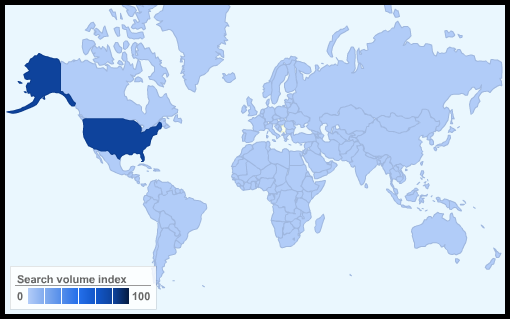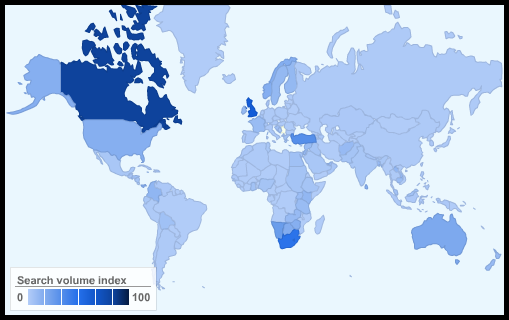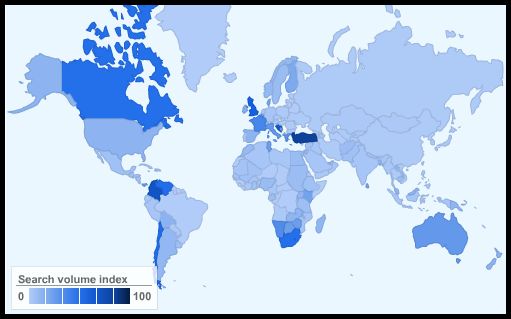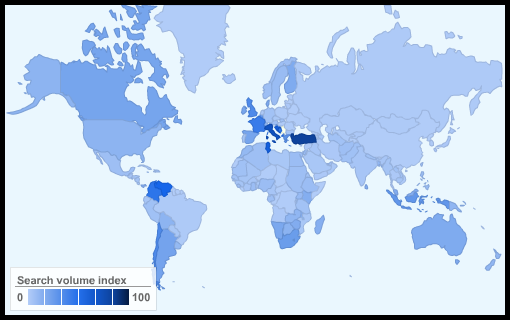![]() Facebook is easily the most widely used social network in the world today, an international success. Since its start in 2004, it has grown to more than 300 million active users, which is unprecedented. No social network has ever been as big as Facebook is now.
Facebook is easily the most widely used social network in the world today, an international success. Since its start in 2004, it has grown to more than 300 million active users, which is unprecedented. No social network has ever been as big as Facebook is now.
This post takes a look at Facebook’s geographic expansion from its start in 2004 until today in 2009, showing how its popularity has grown year by year.
The maps below are based on Google search data. We have found over and over again that a high search interest translates well into actual popularity of an online service.
2004
In its first year, Facebook, or ”The Facebook” as it was called back then, was a US-only affair and restricted to college students.

More Google search insights for Facebook in 2004 available here.
2005
Not much was happening in terms of international spread in 2005, which is understandable because Facebook was restricted to US college and high school students, the latter on an invitation-only basis. This is the year when Facebook acquired the domain name “facebook.com” for $200,000 (dropping the use of “thefacebook.com”).

More Google search insights for Facebook in 2005 available here.
2006
This year Facebook finally opened up its service to the general public (in September 2006), and the effect can be clearly seen. Interest in Facebook is starting to spread outside the US in a noticeable way. Canada, the UK and, of all places, Puerto Rico show a marked interest in Facebook.

More Google search insights for Facebook in 2006 available here.
2007
Now things are really starting to happen. In Canada, interest has soared. Interest in the UK is strong, and Facebook is taking off in South Africa and Turkey as well. Interest is growing all across the world, including places like Australia, Botswana, Namibia, Trinidad and Tobago. This year Facebook launched its Facebook Platform to allow the development of third-party applications for the service, a move that has resulted in thousands of applications that tie into Facebook.

More Google search insights for Facebook in 2007 available here.
2008
Turkey (of all places) seems to have the highest interest in Facebook relative to the size of its population. Interest has also blossomed in places like Colombia, Croatia, Chile, Venezuela and France. At this point in time it is widely known that Facebook is growing quickly outside the US. This does not, however, mean that it is not growing in the US. In fact, Facebook passed MySpace as the dominant social network in the US this year according to Comscore.

More Google search insights for Facebook in 2008 available here.
2009
Interest remains blazing hot in Turkey this year as well, followed by Italy, Croatia, Tunisia, and countries like Venezuela, France and Chile among others. It’s basically spreading all over the world aside from the few regions where Facebook access is blocked (most notably China).

More Google search insights for Facebook in 2009 available here.
Explosive world-wide growth
These days, Facebook is pretty much a world-wide phenomenon and considering how fast the service is still growing, it’s hard to tell when it will cool off. Even here in little Sweden, Facebook is huge.
By the way, if the title of this post sounds familiar, it’s because we did a similar analysis of Twitter’s geographic spread some time ago, which is arguably the only social network that is even close to generating the amount of buzz lately that Facebook has had in the last couple of years. They are of course quite different beasts, and Facebook is huge in a way that Twitter isn’t even close to yet. Still, it’s interesting to compare how differently they have spread across the world. Both are growing like crazy, that is one thing that’s for sure.
A note on the data: These numbers from Google are normalized, i.e. they show the regional interest relative to the number of internet users in each country (or searches made in each country, we’re not sure what method Google uses). In other words, they don’t necessarily correspond to where Facebook has the most users, but where it is garnering the most interest. That’s how smaller countries can rank relatively high on the list, because a large part of their population (regardless of population size) search for information about Facebook.



























